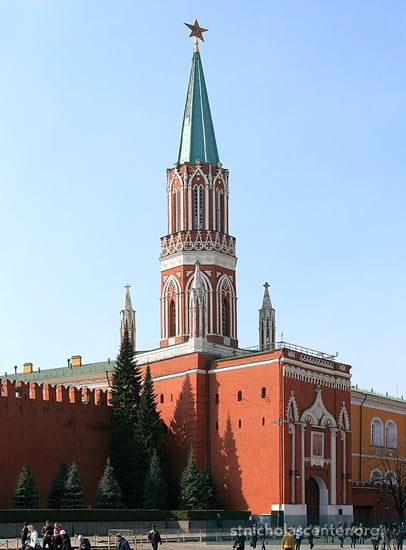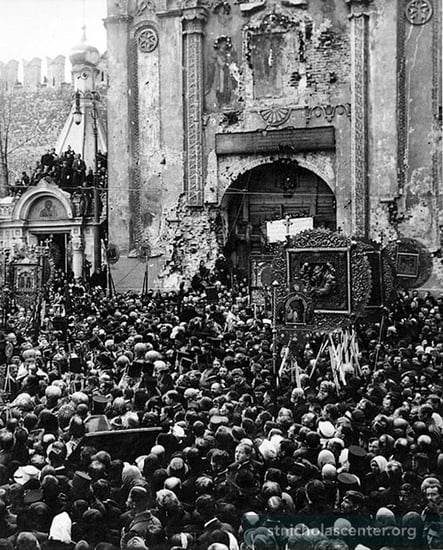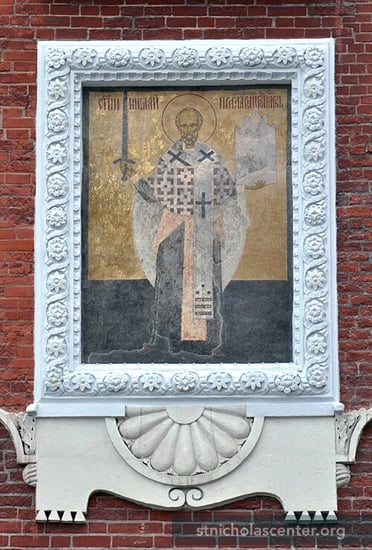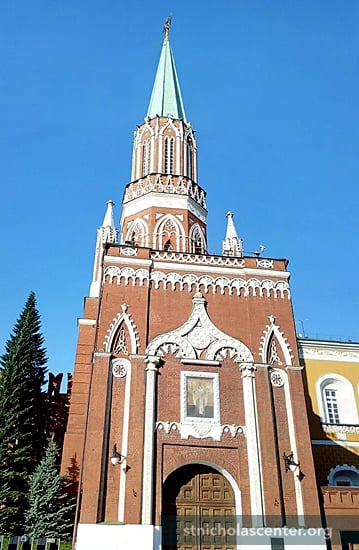Icon, Lost and Found
The story of the icon of St. Nicholas on Nikolskaya Tower of the Moscow Kremlin and how it has miraculously survived fire, bombardment, and disappearance.
 Photo: Wikimedia Commons, used under Creative Commons Attribution-ShareAlike 3.0 Unported license |
The Moscow Kremlin St. Nicholas (Nikolskaya) Tower was built in 1492, the year before Columbus sailed the ocean blue. The tower formed a gateway into the Kremlin on the north. The St. Nicholas Mozhaisk icon, from the late 15th - early 16th century, set above the gate gave the tower its name. It is said that people came to solve disputes and arguments beneath the icon. Along with the Kremlin's other icons, it served as a symbol of Holy Russia; the icon blessed the coronation and military processions that passed beneath for nearly 500 years.
Over the centuries, this prominent placement has exposed the icon to threats of damage and destruction.
First, in 1812 when Napoleon retreated from Moscow, the tower, with the rest of the Kremlin, was set on fire. The spire was blown up and the roof over the gateway destroyed. However, the icon itself survived unscathed. This was regarded as miraculous. When the tower was rebuilt (1916-18) the four corner turrets were added.
Next, during the October Revolution St. Nicholas Tower was badly damaged. An eyewitness reported, "Both Nikolsky Tower and Nikolsky Gate were damaged by explosives, machine-gun fire, hand grenades and rifle shots. The icon-niche and the overhanging eave were completely destroyed. An icon of an angel on one side was knocked down, and on the other side, damaged by gunfire. Amidst all this destruction, the icon of St. Nicholas survived, but there is a pattern of bullet holes surrounding the head and shoulders of the saint. At first it appears that the icon is not there, but upon closer observation, one sees at first the stern visage of St Nicholas, then a 'wound' to the right temple, and then finally one sees this miraculous icon more and more clearly." Thus the icon survived a second time.
The Bolsheviks covered the damaged icon with red cloth, keeping the it securely out of sight. In May 1918 the red cloth was torn into shreds and the icon miraculously appeared.
Days later, on St. Nicholas' springtime feast day, Patriarch Tikhon called the festival processions to come into Red Square. The Square was filled to capacity and beyond. The Red Army fired rifle shots from the walls while the faithful served a moleben to St. Nicholas before St. Nicholas the Wonderworker icon.
 Photo: Wikimedia Commons, public domain |
 Photo: Thomas Ludwig |
Sometime later the icon completely disappeared from view. Just when is not known, though it may have been in 1935 when the red star was installed on the top of the spire or, in 1937, when the twentieth anniversary of the Bolshevik Revolution was celebrated. Elena Gagarina, director of the Kremlin Museums, believes the icons were probably removed under Stalin's orders in 1934 when the state restoration workshops were closed and the director arrested. At this time political purges were growing and it may have been when it was decided to remove all religious icons from the Kremlin walls. Whenever it was, a blank rectangle, first red, later white, took the place of the revered icon.
No documentation has been found telling what happened to Kremlin icons, nor witnesses to tell of their fate.
 Photo: pravoslavie.ru |
 State Museum of the History of Religion, St. Petersburg, Russia |
In 2004 the Russian Orthodox Church Outside of Russia appealed for the icons to be restored to the Kremlin towers. A photograph, purported to have been taken in 1917 after Revolution's damage, showed St. Nicholas with a sword in his right hand and a city or church in the other (St. Nicholas of Mozhaisk), bullet holes around his head and right hand holding the city. The photo had been published in emigre periodicals and later became the symbol of the White Movement and Russian emigres.
A plan emerged to recreate the icon, based on the photograph. Permission was needed and sought from the Federal Security Service that supervises the Kremlin and UNESCO, because the Moscow Kremlin is a World Heritage Site. Such replacement did not fit with UNESCO's World Heritage regulations and permission was not granted.
In 2007 the Fund of St Andrew the First-Called (St. Andrew's Foundation) was authorized to try to find out what had happened to the icons. The hope was that they had been hidden away in a museum's archives and would be found. This investigation had the blessing of both the patriarch and the government. The icons were not found.
In May 2010 professional restorers made exploratory openings in the plaster in the icon niches of the Nicholas and Savior towers. They discovered a layer of metal mesh.
When orders had been given to remove the icons from sight, the icons were not destroyed. Instead, highly skilled workers, no doubt risking their lives and families, hid the icons in a way that preserved them. A metal grating was placed over the icons painted surface. Then the metal mesh was plastered over and painted red. Air space between the icon surface and the metal grating protected the icons. They icons were completely covered up and presumed to have been simply plastered over. Instead, they were hidden and enclosed in such a way that they could be recovered.
Careful restoration commenced and the first restored icon of the Savior on Spasskaya Tower and St. Nicholas on Nikolskaya Tower were unveiled by President Medvedev and Patriarch Kirill on August 28th, 2010, the day of the Feast of the Dormition on the Orthodox calendar. The St. Nicholas icon was unveiled and blessed by Patriarch Kirill on November 4, 2010, Day of National Unity in Russia that commemorates the liberation of Moscow from foreign intervention in 1612.
 Photo: Sergius, Wikimedia Commons, Used under Creative Commons Attribution-ShareAlike 3.0 Unported license |
 Photo: Dimitry Sklyarenko, Wikimedia Commons, used under Creative Commons Attribution 3.0 Unported license |
Thus, two icons that graced the Kremlin for nearly five hundred years were returned to view following an absence of nearly a century.
SOURCES
"The Kremlin Gates: Damaged Ancient Icons to Return to Red Square," pravoslavie.ru
"Lost Treasures Return to Russia's Red Square" AOLNews
"Long-Lost Jesus Icon Returns to Kremlin Gates," The St. Petersburg Times
"Russian Patriarch unveils Kremlin icon hidden since 1917," Insights, uca.org.au
"Mysteries of Moscow's Kremlin," Russia: Beyond the Headlines
"The St. Nicholas (Nikolskaya) Tower" Moscow.info

